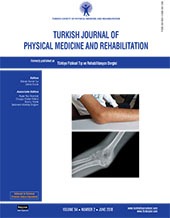The relationship between body composition and knee osteoarthritis in postmenopausal women
Patients and methods: This retrospective, cross-sectional study included a total of 212 postmenopausal women (mean age 59.9±6.2 years; range, 46 to 76 years). Descriptive characteristics were recorded and height was measured using a stadiometer. Body weight, fat mass, and lean mass were estimated using bioelectrical impedance analysis. X-rays of the knees were obtained. Knee OA was radiographically diagnosed according to the Kellgren-Lawrence criteria. Based on the radiographic knee OA diagnosis the women were divided into two groups. Logistic regression analyses were used to examine the associations between the body composition measures and knee OA.
Results: Knee OA was present in 117 women. Body Mass Index, body weight, fat mass, and lean mass were all significantly associated with knee OA after adjusting for confounding factors such as age, height, and physical activity (p<0.001). When assessed together with lean mass in a multivariate regression model, fat mass was closely and significantly found to be related to knee OA, compared to lean mass (p<0.001, OR: 1.17). Furthermore the fat mass/lean mass ratio was positively associated with knee OA (p<0.001).
Conclusion: In postmenopausal women body weight was significantly and positively associated with knee OA and among the components that constitute body weight, fat mass was closely and significantly associated with knee OA compared to lean mass. This result suggests that the relationship between obesity and knee OA is mainly based on the fat mass, and supports the importance of systemic metabolic effects of adiposity in this relationship.
Keywords : Body composition; fat mass; knee osteoarthritis; lean mass; postmenopausal women

















